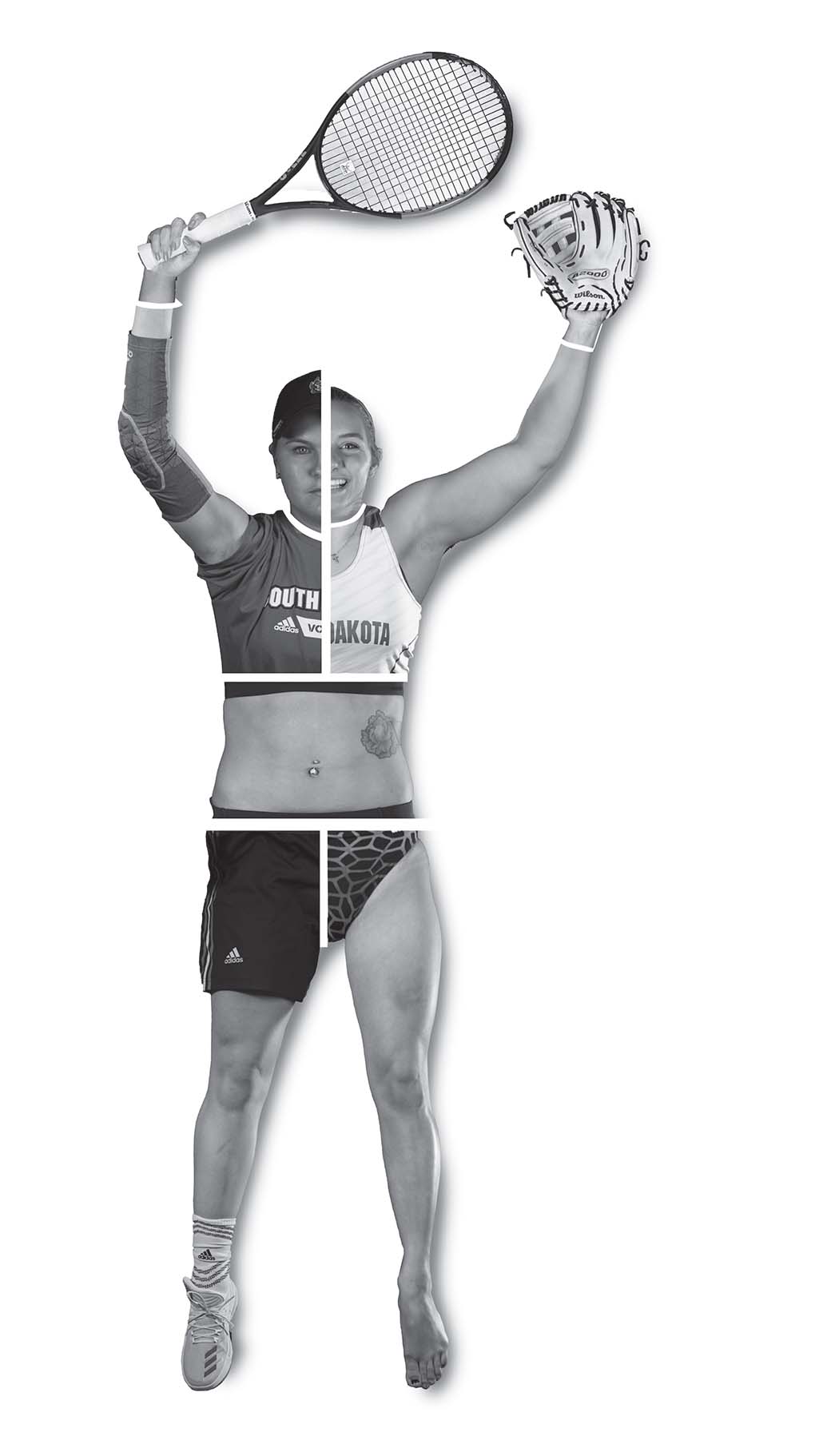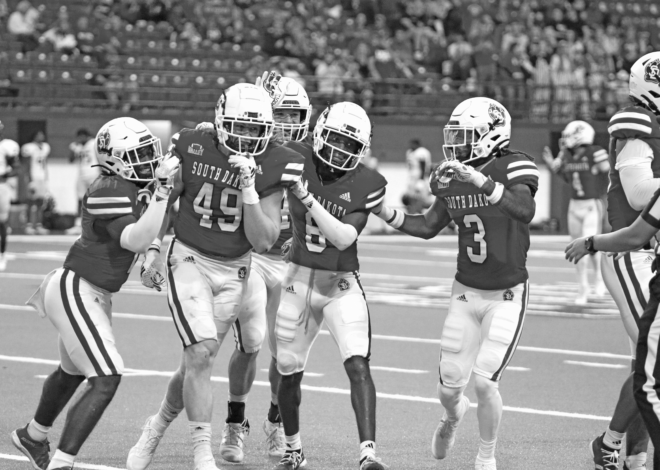
Hidden figures: Female athletes recount struggles with body insecurities

Walking into the weight room at USD, there are large platforms, lifting racks, various workout machines and free weights.
Off to the side is an indistinguishable scale shoved in the entryway near the grab-and-go snacks and recovery drinks.
For many female athletes, the lime green digit lighting up the scale screen not only determines how in shape they are, but how suitable they are to perform in their sport.
“It’s hard to weigh in where teammates can see you, not because they would judge you, but just because they know,” said Emily Winckler, a senior on the softball team. “They know if you gain 10 pounds or lose three pounds… it’s the self-confidence that you start losing because you are already self-conscious about it in front of people.”
The body image struggle
Ellie Coyle, a sophomore on the women’s cross country team, said body image is an issue she sees on the track.
“It’s hard to see girls self-conscious when we are running as many miles as we can during the week and pushing our bodies as hard as we can… who cares what our body looks like?” she said. “As long as you are healthy and you are able to do what you want in life, that is all you can really ask for.”
Women have a unique struggle in combating the perception that they should be both athletic and feminine, said Mary Wester, a junior on the track and field team.
“Some girls feel like they need a man’s approval to feel feminine and once you realize you don’t need that, you’re way happier with yourself and can really grow as a person,” Wester said.
The balance between strong, skinny and in shape is a tough ideal body image to achieve.
“Girls already have this picture of what we should be looking like, especially in sports that rely heavily on being in shape,” said Abby Dufrane, a senior on the golf team. “This is becoming a bigger issue within golf. We need to be in shape all the time … and we walk.”
This ideal picture can stem from social media, celebrities and fitness stars, but also their own teammates.
“You see social media posts of teammates with rocking bodies and everything just seems so perfect and you feel like you’re not that,” Coyle said. “It puts a lot of added stress and anxiety. Some girls have said that they almost didn’t give themselves a chance to try cross country here because of the way that they looked.”
‘Pressure to be pretty’
In a study conducted by ESPN, 68 percent of female athletes felt pressure to be “pretty.”
“It was hard growing up, especially when I was more muscular than most of the boys,” Wester said. “It’s hard to feel feminine because you start to relate more to the males and to their love for athletics and lifting. Also, I couldn’t wear clothes other girls get to wear because of my muscles and that hurt how I saw myself and how I felt others saw me.”
Each body is expected to perform in a different way. Coaches instruct their athletes to treat their body like a well-oiled machine.
“We focus so much on strength and conditioning that we lift a lot and all the time,” Winckler said. “So I gained a lot of weight my freshmen year, and it was muscle but all I could think was, ‘Wow I’m gaining a lot of weight… why?’ The mindset of being an athlete and using your body as a tool, a piece of equipment, essentially, and you have to train it and condition it.”
Every sport has different criteria for how each athlete should focus on different aspects of being strong. Some teams need to be mentally strong, others physically strong and most, a combination of both.
“Last year the golfers lifted at the same time as the throwers … talk about just feeling small and feeling like you’re not enough… even though we know that our sport is different than their sports and we have to be strong in a lot of different ways, like mentally, it’s an intimidating thing,” Dufrane said. “You feel like you need to work harder to become smaller and stronger at the same time, even if you don’t really have to do that you feel inside like you need to, that is becoming the problem.”
The comparison doesn’t stop when practice is over. Women are constantly surrounded by messages on social media of what they should look like.
“Sometimes you wish you could look like another girl, but in reality, that girl that you’re talking about is going through some very serious things,” Coyle said. “Where she has an eating disorder or a really bad mental problem that is going on. You have to ask yourself is it worth having that perfect body to sacrifice your mental health?”
Many female student-athletes go through a transition coming into college. They often gain weight because coaches push them in weight room harder than they’re used to.
“Once I got to college I started to realize what I can do with my body,” Wester said. “It also helps that my teammates, especially the throwers, feel the same way about theirs. I started to feel more feminine because I realized it wasn’t about my muscles mass it was about what was on the inside that counts.”
Health and nutrition
Top female college athletes are more than twice as likely to develop dangerous eating disorders like anorexia and bulimia compared to the general college-age female population, according to the National Association of Anorexia Nervosa and Associated Disorders.
A lesser-talked about issue involves disordered eating habits. A recent Yale study found that 25 percent of female collegiate athletes struggle with disordered eating.
“We tend to see it more in weight–class sports where leanness is emphasized: gymnastics, dance, track or the cross country where thin or lean physique is emphasized,” said Elizabeth Kapsarek, a USD nutritionist.
According to the Diagnostic and Statistical of Mental Disorders, disordered eating is defined as “a wide range or irregular eating behaviors that do not warrant a diagnosis of a specific eating disorder.”
“They might just have disordered habits like consciously counting every calorie that comes in or out. Or their weight keeps going down, they have already met their goal weight, but now they’ve fallen into disordered eating habits, or even an eating disorder to keep their weight going down but it’s not necessarily healthy anymore,” Kasparek said. “Or obsessive habits where they are meticulously counting every calorie that goes into their body and how much is getting burned off.”
Starting the conversation
“I think everyone always sees it – all of us girls think about it, but no one wants to step up and speak about it,” Dufrane said.
Women are starting to talk about this issue more and more, and are helping younger girls who may struggle with similar body issues.
“Now I volunteer with Girls on the Run, and we talk to the girls there about how to love themselves,” Coyle said. “We want to stop this from happening in younger generations. If all of us older girls have already struggled through it, let’s go back to the younger girls and stop it from happening all over again.”
This is the first part of a three-part series on student-athletes and body image.

